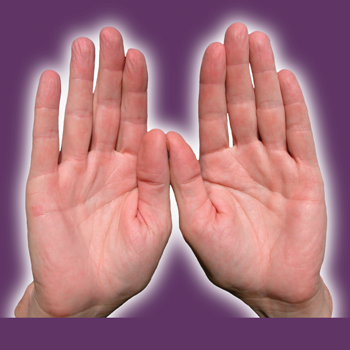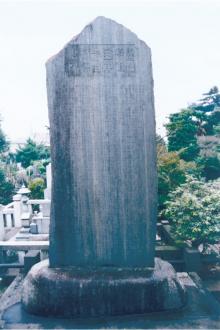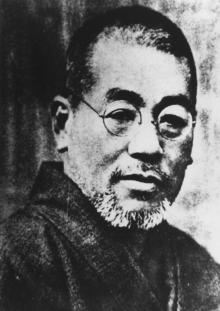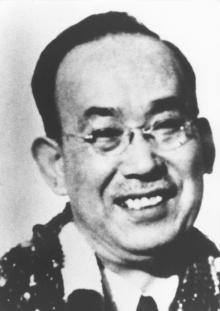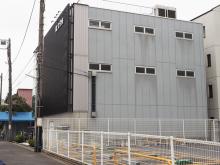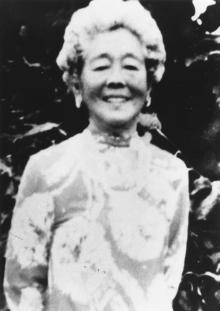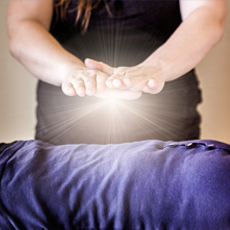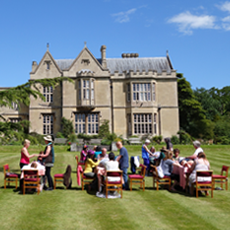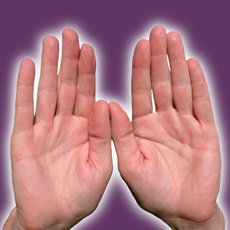The following referenced history of Reiki is taken from Reiki, The Healing Touch, by William Lee Rand and has been carefully researched to contain verified information from dependable sources. You have permission to copy and paste this history including the photos on to your own web site as long as you use the entire text and do not make changes to it.
There have been many attempts to explain the history of Reiki, but unfortunately, in the past, many of them have been based more on myth and an attempt to validate a particular style of Reiki and for the most part, lacked accurate information. Realizing the need for a factually based history of Reiki, I’ve spent over twenty years researching this information based on written records and interviews with those close to its development. The result is the following history of Reiki, which is derived from evidence based facts.
Reiki Before Usui
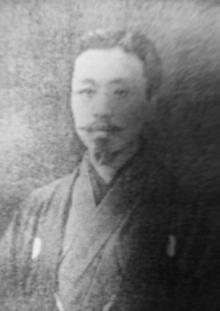 Mataji Kawakami created Reiki Ryoho in 1914. Author of Reiki Healing and Its Effects, published 1919.
Mataji Kawakami created Reiki Ryoho in 1914. Author of Reiki Healing and Its Effects, published 1919.Many consider that Mikao Usui or Usui Sensei as we reverently refer to him, was the creator of Reiki and that the word Reiki applies only to the healing modality he discovered and developed. Yet, when researching the facts concerning the origin of Reiki as a healing modality, we find that prior to Usui Sensei developing his style of Reiki, there were at least four other styles of Reiki healing that were being practiced in Japan. This information comes from Hiroshi Doi Sensei and from Toshitaka Mochitzuki Sensei, two Japanese Reiki researchers. A more detailed understanding of this subject is explained in the book, An Evidence Based History of Reiki.(1, 2)
In 1914, Matiji Kawakami, a Japanese therapist, created a healing style he called Reiki Ryoho and in 1919, he published a book titled Reiki Ryoho to Sono Koka, or Reiki Healing and Its Effects. The other Reiki healing styles in use at the time were: Reikan Tonetsu Ryoho created by Reikaku Ishinuki, Senshinryu Reiki Ryoho created by Kogetsu Matsubara and Seido Reishojutsu created by Reisen Oyama. It was during the time that these Reiki styles were already in use that in March 1922, Usui Sensei had his mystical experience on Kurama yama in which he was given the Reiki energy and from this developed his style of Reiki, which he called Usui Reiki Ryoho. It is interesting that Usui Sensei chose this name as it tends to indicate that he knew of the other styles of Reiki Ryoho in use and was indicating that this was his style of Reiki Ryoho. And because of circumstances that developed during World War II along with the work of Takata Sensei mentioned later in this section, the other forms of Reiki fell into disuse or remained relatively unknown while Usui Reiki continued to be practiced and grew in popularity
In considering what should or should not be called Reiki, we must consider that not only have there been many systems of Reiki healing that are original and do not have a lineage going back to Usui Sensei, but that the Reiki energy has been around at least for thousands of years and in fact some feel it has been around since the beginning of time. Reiki energy is something that anyone can make use of and of course many have, so with this in mind, it appears logical to assume that any system that makes use of Reiki energy can be called Reiki, not just those systems that can be traced back to Usui Sensei.
However, because of conditions in Japan after World War II and the fact that Hawaya Takata had brought Reiki to the west, Usui Reiki became the predominate form of Reiki practiced throughout the world. Because of this, a thorough understanding of Usui Reiki is important as it will give us a foundation for understanding Reiki, making it easier for us to connect with its essence.
The Inscription on the Usui Memorial
The history of Usui Reiki begins with a look at the inscription on the memorial stone that was erected in 1927 in Tokyo, Japan in memory of Mikao Usui Sensei, founder of the Usui Reiki healing system.
The inscription on the Usui Memorial, dating from 1927, was written by Juzaburo Ushida, a Shihan (teacher) who was trained by Usui Sensei and able to teach and practice Reiki the same way that he did.(3) He also succeeded Usui Sensei as president of the Usui Reiki Ryoho Gakkai (Usui Reiki Healing Method Society). Masayuki Okata, also a member of the Usui Reiki Ryoho Gakkai, was the editor. The English translation was done by Tetsuyuki Ono and is reprinted here from the book, lyashino Gendai Reiki- ho, with permission from the author, Hiroshi Doi.
The large kanji (adopted Chinese characters used in the Japanese writing system) at the top of the memorial stone reads: “Memorial of Usui Sensei’s Virtue.” The remainder of the inscription reads as follows:
What you can naturally realize through cultivation and training is called “VIRTUE” and it is called “MERIT” to spread a method of leadership and relief and practice it. It is people of many merits and a good deal of virtue that can be eventually called a great founder. People who started a new learning and founded a fresh sect among sages, philosophers, geniuses etc., named from the ancient times, were all those as mentioned above. We can say that Usui-Sensei is also one of those people.
He started newly a method to improve body and spirit based on REIKI in the universe. Hearing of the rumor, people who would like to learn the treatment and undergo the cure gathered from all quarters all at once. Really, it was very busy indeed.
Usui-Sensei, whose popular name is Mikao and whose pen name is Gyohan, came from Taniai-village, Yamagata- district, Cifu Prefecture, and had forefathers named Tsunetane Chiba who had played an active part as a military commander between the end of Heian Period and the beginning of Kamakura Period (1180–1230). His father’s real name is Taneuji and his popular name is Uzaemon. His mother came and got married from the family named Kawai.
Usui-Sensei was born on 15th August, 1865. Having learned under difficulties in his childhood, he studied hard with efforts and he was by far superior in ability to his friends.
After growing up, he went over to Europe and America, and also studied in China. In spite of his real ability, however, he was not always successful in life. Although he was compelled to lead an unfortunate and poor life so often, he strove much more than before to harden his body and mind without flinching from the difficulties.
One day, Usui-Sensei climbed Mt. Kurama, where he began to do penance while fasting. Suddenly on the twenty first day from the start, he felt a great REIKI over his head, and at the same time as he was spiritually awakened he acquired the REIKI cure. When he tried it on his own body and members of his family also, it brought an immediate result on them.
Having said “It is much better to give this power widely to a lot of people in the world and enjoy it among them than to keep it exclusively by his family members,” Usui-Sensei moved his dwelling to Aoyama Harajuku, Tokyo in April, 1922 and established an institute, where the REIKI cure was instructed openly to the public and the treatment was given, too. People came there from far and near to ask for his guidance and cure, and they over-flowed outside, making a long line.
Tokyo had a very big fire caused by a great earthquake in Kanto district in September, 1923, when the injured and sick persons suffered from pains everywhere. Usui-Sensei felt a deep anxiety about that, and he was engaged in a cure, going around inside the city every day. We can hardly calculate how many persons were saved from death with his devotion. His activities of relief, in which he extended his hands of love over to those suffering people against this emergent situation, can be outlined as noted above.
Thereafter, his training center became too small to receive the visitors, so he built a new house in Nakano outside the city in February 1925 and transferred there. As his reputation got higher and higher, it was so often when he received an offer of engagement from everywhere throughout the nation. In accordance with these requests he traveled to Kure and Hiroshima, then entered Saga and reached Fukuyama. It was at the inn at which he stayed on his way that he caught a disease abruptly, and he passed away at the age of sixty-two.
His wife got married, coming from the Suzuki family, and she is named Sadako and has a son and a daughter. The son’s name is Fuji, and he succeeds to the Usui family.
Usui-Sensei’s natural character was gentle and prudent, and he did not keep up appearances. His body was big and sturdy, and his face was always beaming with a smile. But when he faced the difficulties he went ahead with a definite will and yet persevered well, keeping extremely careful. He was a man of versatile talents and also a book lover, knowing well in the wide range from history, biography, medical science, canons of Christianity and Buddhism and psychology up to magic of fairyland, art of curse, science of divination and physiognomy.
In my opinion, it is evident to everybody that Usui-Sensei’s cultivation & training were based on his career of art and science, and the cultivation & training became a clue to create the REIKI cure.
Reviewing the fact, I understand what the REIKI cure is aiming at is not only to heal the diseases but also to correct the mind by virtue of a God-sent spiritual ability, keep the body healthy and enjoy a welfare of life. In teaching the persons, therefore, we are supposed to first let them realize the last instructions of the Emperor Meiji, and chant the 5 admonitions morning and evening to keep them in mind.
The 5 admonitions in question are:
1. Don’t get angry today.
2. Don’t be grievous.
3. Express your thanks.
4. Be diligent in your business.
5. Be kind to others.
These are really the important precepts for a cultivation, just the same as those by which the ancient sages admonished themselves. Usui-Sensei emphasized that ‘This is surely a secret process to bring a good fortune and also a miraculous medicine to remedy all kinds of diseases,’ by which he made his purpose of teaching clear and accurate. Furthermore, he tried to aim at making his way of guidance as easy and simple as possible, so nothing is difficult to understand therein. Every time when you sit quietly and join your hands to pray and chant morning and evening, you can develop a pure and sound mind, and there is just an essence in making the most of that for your daily life. This is the reason why the REIKI cure can very easily spread over anybody.
The phase of life is very changeable in these days, and people’s thoughts are apt to change, too. Could we fortunately succeed in spreading the REIKI cure everywhere, we feel sure that it would have to be very helpful in order to prevent people from disordering their moral sense. It never extends people anything but the benefits of healing long term illness, chronic disease and bad habit.
The number of pupils who learned from Usui-Sensei amounts to more than 2000 persons. Some leading pupils living in Tokyo among them gather at the training center and take over his work, while other pupils in the country also do everything to popularize the REIKI cure. Although our teacher already passed away, we have to do the very best to hand the REIKI cure down to the public forever and spread it much more. Ah! What a great thing he did; to have unsparingly given people what he had felt and realized by himself!
As a result of our pupils’ recent meeting and discussion, we decided to erect a stone monument at the graveyard in his family temple so that we may bring his virtuous deed to light and transmit it to posterity; so, I was requested to arrange an epitaph for the monument. As I was much impressed by his great meritorious deed and also struck by our pupils’ warm hearts of making much of the bond between master and pupil, I dared not refuse the request, but described the outline.
Therefore, I do expect heartily that people in the future generations would not forget to look up at the monument in open-eyed wonder.
— Usuida, in February, 1927. Edited by Masayuki Okada, The Junior 3rd Rank, the 3rd Order of Merit, Doctor of Literature. Written by Juzaburo Usuhida, The Junior 4th Class of Services, Rear Admiral.
Mikao Usui
Mikao Usui, or Usui Sensei as he is called by Reiki students in Japan, was born August 15, 1865 in the village of Taniai in the Yamagata district of Gifu prefecture, which is located near present-day Nagoya, Japan.(4)
He had an avid interest in learning and worked hard at his studies. As he grew older, he traveled to Europe and China to further his education. His curriculum included medicine, psychology and religion as well as the art of divination, which Asians have long considered to be a worthy skill.(5) Usui Sensei also became a member of the Rei Jyutu Ka, a metaphysical group dedicated to developing psychic abilities.(6) He had many jobs including civil servant, company employee and journalist, and he helped rehabilitate prisoners.(7) Eventually he became the secretary to Shinpei Goto, head of the department of health and welfare who later became the mayor of Tokyo. The connections Usui Sensei made at this job helped him to also become a successful businessman.(8)
The depth and breadth of his experiences inspired him to direct his attention toward discovering the purpose of life. In his search he came across the description of a special state of consciousness that once achieved would not only provide an understanding of one’s life purpose, but would also guide one to achieve it. This special state is called An-shin Ritus-mei (pronounced on sheen dit sue may). In this special state, one is always at peace regardless of what is taking place in the outer world. And it is from this place of peace that one completes one’s life purpose. One of the special features of this state is that it maintains itself without any effort on the part of the individual; the experience of peace simply wells up spontaneously from within and is a type of enlightenment.
Usui Sensei understood this concept on an intellectual level and dedicated his life to achieving it; this is considered to be an important step on Usui Sensei’s spiritual path. He discovered that one path to An-shin Ritsu-mei is through the practice of Zazen meditation. So he found a Zen teacher who accepted him as a student and began to practice Zazen. After three years practice, he had not been successful and sought further guidance. His teacher suggested a more severe practice in which the student must be willing to die in order to achieve An-shin Ritsu-mei.(9, 10)
So with this in mind he prepared for death and in February, 1922, he went to Kurama yama, a sacred mountain north of Kyoto. He went to fast and meditate until he passed to the next world. It must be kept in mind that he was not looking to discover a method of healing, but was seeking to experience this special spiritual state. In addition, we know there is a small waterfall on Kurama yama where even today people go to meditate. This meditation involves standing under the waterfall and allowing the water to strike and flow over the top of the head, a practice that is said to activate the crown chakra. Japanese Reiki Masters think that Usui Sensei may have used this meditation as part of his practice. In any case, as time passed he became weaker and weaker. It was now March 1922 and at midnight of the twenty-first day, a powerful light suddenly entered his mind through the top of his head and he felt as if he had been struck by lightning; this caused him to fall unconscious.
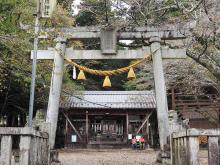 Tenyo Shrine which is a short walk from where Usui Sensei was born in the village of Taniai. The Torii or archway is inscribed with words indicating that it was donated by Usui Mikao in 1923.
Tenyo Shrine which is a short walk from where Usui Sensei was born in the village of Taniai. The Torii or archway is inscribed with words indicating that it was donated by Usui Mikao in 1923. As the sun rose, he awoke and realized that whereas before he had felt very weak and near death from his fasting, he was now filled with an extremely enjoyable state of vitality that he had never experienced before; a miraculous type of high frequency spiritual energy had displaced his normal consciousness and replaced it with an amazingly new level of awareness. He experienced himself as being the energy and consciousness of the Universe and that the special state of enlightenment he had sought had been given to him as a gift. He was overjoyed by this realization.
When this happened, he was filled with excitement and went running down the mountain to tell his Zen master of his great good fortune. On his way down he stubbed his toe on a rock and fell down. And in the same way anyone would do, he placed his hands over the toe, which was in pain. As he did this, healing energy began flowing from his hands all by itself. The pain in his toe went away and the toe was healed. Usui Sensei was amazed by this. He realized that in addition to the illuminating experience he had undergone, he had also received the gift of healing. He also understood that this was his life purpose; to be a healer and to train others.(11)
In April 1922, he moved to Tokyo and started a healing society that he named Usui Reiki Ryoho Gakkai (Usui Reiki Healing Method Society). He also opened a Reiki clinic in Harajuku, Aoyama, Tokyo. There he taught classes and gave treatments.(12)
At first, all Usui Sensei had was the healing energy. Over time he developed his system of Reiki practice. Most of these developments came in 1923 after the Great Kanto earthquake and tsunami that did extensive damage in Tokyo and killed and injured many thousands of people. Because there were so many people in need of healing, Usui Sensei decided he needed to do something to speed up his ability to train teachers.
It was at this time that he developed many of his practitioner techniques such as Gassho, Byosen scanning, Reiji-ho, Gyoshi ho, Seishin-to-itsu and so forth. He also developed a formal attunement method or Reiju kai, making it easier for others to learn Reiki and to become teachers. Prior to this, the method he used to pass on the Reiki ability was to simply hold the students hands, but this took a long time. The Reiju kai made transferring the Reiki ability much faster. Also, he had many different ways he performed the Reiju Kai, not just one.(13) During this time he also developed the Reiki symbols of which he had only three. These are the three symbols that we currently receive in Reiki II, which he called Okuden. He did not have a Master symbol. This important point was confirmed by Hiroshi Doi Sensei, a member of the Gakkai, and in discussions he had with several of the Gakkai presidents and many of the Shinpiden members.(14) This idea was also confirmed by Arjava Petter Sensei, who had contact with Shinpiden teachers from the Gakkai and with its president.(15)
These same sources also indicate that Usui Sensei also gave many attunements to each student, not just one or one set. The purpose of the student receiving the attunement over and over was that this process continually acted to refine and develop one’s ability to channel Reiki energy, thus making the energy one channeled more versatile and able to heal a wider range of conditions, to heal more deeply and in a shorter time. The philosophy of Usui Sensei was that there is no limit to the quality and effectiveness of the Reiki energy available in the universe and an important purpose for all students was to continually seek to improve the quality and effectiveness of the Reiki energy one is able to channel.(16)
He called his system of healing Shin-Shin Kai-Zen Usui Reiki Ryo-Ho (The Usui Reiki Treatment Method for Improvement of Body and Mind)(17) or in its simplified form Usui Reiki Ryoho (Usui Reiki Healing Method).
The first degree of his training was called Shoden (First Degree) and was divided into four levels: Loku-Tou, Go-Tou, Yon-Tou and San-Tou. (Note that when Takata Sensei taught this level, which in the West we refer to as Reiki Level I, she combined all four levels into one. This is most likely why she did four attunements for Level I.) The next degree was called Okuden (Inner Teaching) and had two levels: Okuden-Zen-ki (first part), and Okuden-Koe-ki (second part). The next degree was called Shinpiden (Mystery Teaching), which is what Western Reiki calls Master level. The Shinpiden level includes, Shihan-Kaku (assistant teacher) and Shihan (venerable teacher).(18)
Demand for Reiki became so great that Usui Sensei outgrew his clinic, so in 1925 he built a bigger one in Nakano, Tokyo. Because of this, his reputation as a healer spread all over Japan. He began to travel so he could teach and treat more people. During his travels across Japan he directly taught more than 2,000 students and initiated twenty Shihan,(19) each being given the same understanding of Reiki and approved to teach and give Reiju in the same way that he did.(20)
The Japanese government issued him a Kun San To award for doing honorable work to help others.(21) While traveling to Fukuyama to teach, he suffered a stroke and died on March 9, 1926.(22) His grave is at Saihoji Temple, in Suginami, Tokyo, although some claim that his ashes are located elsewhere.
After Usui Sensei died, his students erected a memorial stone next to his gravestone. Mr. J. Ushida, a Shihan trained by Usui Sensei, took over as president of the Usui Reiki Ryoho Gakkai and was responsible for creating and erecting the Usui Memorial stone and ensuring that the gravesite would be maintained. Mr. Ushida was followed by Mr. Ilichi Taketomi, Mr. Yoshiharu Watanabe, Mr. Toyoichi Wanami and Ms. Kimiko Koyama. The current successor to Usui Sensei is Mr. Mahayoshi Kondo, who became president in 1998.
Contrary to what we have been told in the West, there is no “lineage bearer” or “Grand Master” of the organization started by Usui Sensei—only the succession of presidents listed above.(23) Among the twenty teachers initiated by Usui Sensei are Toshihiro Eguchi, Jusaburo Guida, Kan’ichi Taketomi, Toyoichi Wanami, Yoshiharu Watanabe, Keizo Ogawa, J. Ushida, and Chujiro Hayashi.(24) Contrary to one version of the Reiki story, Mr. J. Ushida, not Chujiro Hayashi, was the Gakkai’s successor to Usui Sensei. It is also important to note that the first four presidents of the Gakkai who followed Usui Sensei were Shihan who had been trained directly by Usui Sensei, and the last of these was president of the Gakkai through 1975, thus assuring that the Gakkai understanding, practice and teaching methods were the same as that of Usui Sensei.
Chujiro Hayashi
Before his passing, Usui Sensei had asked Chujiro Hayashi Sensei to open his own Reiki clinic and to expand and develop Reiki Ryoho based on his previous experience as a medical doctor in the Navy. Motivated by this request, Hayashi Sensei started a school and clinic called Hayashi Reiki Kenkyukai (Institute). After Usui Sensei’s passing he left the Gakkai.(25)
At his clinic, which was located in Tokyo, he kept careful records of all the illnesses and conditions of his Reiki patients. He also kept records of which Reiki hand positions worked best to treat each illness and condition. Based on these records he created the Reiki Ryoho Shinshin (Guidelines for Reiki Healing Method).(26) This healing guide was part of a class manual he gave to his students. The handbook was to be used only if the practitioner was not able to use Byosen scanning to find the best hand positions to use. Many of his students received their Reiki training in return for working in his clinic.(27)
Hayashi Sensei also changed the way Reiki sessions were given. Rather than have the client seated in a chair and treated by one practitioner as Usui Sensei had done, Hayashi Sensei had the client lie on a treatment table and receive treatment from several practitioners at a time. He also created a new, more effective system for giving Reiju (attunements).(28) In addition, to increase the value his students received while he was traveling, he developed a new method of teaching Reiki. In this method, he taught both Shoden and Okuden (Reiki I&II) together in one five-day seminar. Each day included two to three hours of instruction and one Reiju.(29) Following the Usui method, students were encouraged to receive Reiju on a regular basis from their local Shihan or teacher after completing Hayashi Sensei’s class so as to continue to refine and develop the quality of the Reiki energy that they channeled.
Because of his trip to Hawaii in 1937–38 prior to the Japanese attack on Pearl Harbor, he was asked by the Japanese military to provide information about the location of warehouses and other military targets in Honolulu. He refused to do so and was declared a traitor. This caused him to “lose face,” which meant he and his family would be disgraced and would be ostracized from Japanese society. The only solution was seppuku (ritual suicide), which he carried out. He died honorably on May 11, 1940.(30)
After this, Hayashi Sensei’s wife Chie Hayashi took over his clinic and ran it for some years, but eventually she retired; with no one to take over this position, the clinic came to an end. It is likely that some of Hayashi Sensei’s students continued to teach but most of these have also passed on. In 1999 it was discovered that Chiyoko Yamaguchi Sensei, a Shinpiden or Master student of Hayashi Sensei, was still alive and practicing. She was encouraged to teach and began doing so. Fortunately, I was able to take her Reiki I&II class in 2001 in Kyoto, Japan. Chiyoko Yamaguchi passed on in 2003.
Hawayo Takata
The following is a summary of Takata Sensei’s version of her early years leading up to her contact with Reiki at the Hayashi clinic. It comes from an interview that appeared in The (San Mateo) Times, May 17, 1975 titled “Mrs. Takata Opens Minds to Reiki” by Vera Graham:
She stated that she was born on December 24th, 1900, on the island of Kauai, Hawaii. Her parents were Japanese immigrants and her father worked in the sugar cane fields. She eventually married the bookkeeper of the plantation where she was employed. His name was Saichi Takata and they had two daughters. In October 1930, Saichi died at the age of 34, leaving Mrs. Takata to raise their two children.
In order to provide for her family, she had to work very hard with little rest. After five years she developed severe abdominal pain and a lung condition, and she had a nervous breakdown. Soon after this one of her sisters died and it was Takata Sensei’s responsibility to travel to Japan, where her parents had resettled to deliver the news. She also felt she could receive help for her health issues in Japan.
After informing her parents and attending the funeral, she entered a hospital and stated that she was diagnosed with a tumor, gallstones, appendicitis and asthma. She was told to prepare for an operation but opted to visit Hayashi Sensei’s clinic instead.
Mrs. Takata was unfamiliar with Reiki but was impressed that the diagnosis of Reiki practitioners at the clinic closely matched the doctor’s at the hospital. She began receiving treatments. Two Reiki practitioners would treat her each day. The heat from their hands was so strong, she said, that she thought they were secretly using some kind of equipment. Seeing the large sleeves of the Japanese kimono worn by one, she thought she had found the secret place of concealment. Grabbing his sleeves one day she startled the practitioner, but, of course, found nothing. When she explained what she was doing, he began to laugh and then told her about Reiki and how it worked.
Mrs. Takata got progressively better and in four months was completely healed. She wanted to learn Reiki for herself. In the spring of 1936 she received First Degree Reiki from Dr. Hayashi. She then worked with him for a year and received Second Degree Reiki. Mrs. Takata returned to Hawaii in 1937, followed shortly thereafter by Hayashi Sensei, who came to help establish Reiki there, and his daughter. In February 1938, Hayashi Sensei initiated Hawayo Takata as a Reiki Master.
 This house is where Takata Sensei’s clinic was located in Hilo, Hawaii where she gave Reiki sessions from 1939 to 1949.
This house is where Takata Sensei’s clinic was located in Hilo, Hawaii where she gave Reiki sessions from 1939 to 1949.Takata Sensei practiced Reiki in Hawaii, establishing several clinics, one of which was located in Hilo on the Big Island. She gave treatments and initiated students up to Reiki II. She became a well-known healer and traveled to the U.S. mainland and other parts of the world teaching and giving treatments. She was a powerful healer who attributed her success to the fact that she did a lot of Reiki on each client. She would often do multiple treatments, each sometimes lasting hours and treat difficult cases everyday for months until the client was healed. To help with this process, she often initiated members of a client’s family so they could give Reiki to the client as well.
Takata Sensei had a unique way of practicing and teaching Reiki that was noticeably different than how Usui Sensei or Hayashi Sensei had practiced and taught. The late John Harvey Gray was one of Takata Sensei’s most respected students and in fact she indicated that he would be one of three Reiki Masters that were to carry on her work after she retired.(31) He indicates in his Reiki book that Takata Sensei had changed the way she taught Reiki because she said that the Japanese style was too complicated and would be difficult for the Western mind to learn. Because of this, she said she had simplified the system. This included the development of her own hand position system, which she called the foundation treatment. This consisted of eight hand positions, which were on the abdomen, the shoulders and head. She also included some additional positions for the back if the client needed them.(32) This varied considerably from how Usui Sensei and Hayashi Sensei practiced in that they taught Byosen scanning as the way to find the best hand positions for treatment. They also indicated that Byosen scanning was the most important practice technique for a student to master after the practice of continually receiving repeated Reijus. Yet, Takata Sensei never taught this technique. She also did not teach any of the other methods used by Usui Sensei and Hayashi Sensei such as Gassho, Reiji-ho, Kenyoku, Gyoshi-ho, Koki-ho and so forth. Additionally, she had a different attunement method for each level of Reiki, taught her students that the attunements empowered the symbols and taught a Master symbol that was given to Master students. In her system, the Master symbol was needed in order to give attunements, and it could also be used during Reiki sessions for purposes of healing. She did not encourage her students to receive as many attunements as possible as was taught by Usui Sensei and Hayashi Sensei, but taught that just one set of four attunements for Reiki I and one or two attunements for Reiki II and one for the Master level are all that are necessary.(33)
The simplified system that Takata Sensei taught was effective and has proven to produce valuable results for her students and their clients. Because of this, Takata Sensei can be considered an important innovator of Usui Reiki Ryoho.
One thing that is important to understand is that if it were not for Takata Sensei, Reiki would most likely have fallen into obscurity and never have been practiced by people all over the world; even in Japan it would have been mostly unknown. This is because after World War II, the United States required Japan to unconditionally surrender. This placed the United States in complete control of Japan. One of the conditions the U.S. required is that all those practicing any kind of healing be required to have a license. Some of the healing groups did get licensed, but the Usui Reiki Ryoho Gakkai decided that they did not want to be controlled by a licensing board and instead chose to go underground. They decided that the members were not to talk to anyone outside their group about Reiki and that they would only practice Reiki with each other. This made it difficult for anyone to find out about Reiki in Japan including the Japanese. Also, because it became very difficult for new members to join, the membership slowly declined. This problem exists even now, and the Gakkai membership continues to slowly dwindle. If this continues, at some time in the not too distant future the Gakkai is likely to come to an end.
Because Takata Sensei learned Reiki in Japan and returned to Hawaii and began teaching Reiki before World War II, she prevented Reiki from being lost. She was a great teacher and promoter and taught Reiki classes all over Hawaii and in many parts of the U.S. mainland. Before her passing, she taught 22 Reiki Masters who carried on the tradition.
The Evolution of Reiki
One thing I came to realize from my training experience is that there is no limit to the possibilities offered by Reiki. As demonstrated by Usui Sensei, Hayashi Sensei and Takata Sensei, Reiki is something that is meant to be developed. This is true for the techniques one uses to practice Reiki, but it is also true for the quality of the healing energy.
Reiki energy comes from an infinite source and because of this, regardless of how developed and evolved ones healing energy has become, one will always be channeling only a small portion of the potential healing energy that is available; it is always possible for the quality, effectiveness and benefit of one’s healing energies to improve and this includes what takes place in the Attunements, Placements and Ignitions.
Usui Sensei alluded to this when he said he wasn’t at the top of the Reiki healing system, but one step below.(34) It is also important to note that according to the Bible, Jesus, who is considered by many to be a great healer and spiritual master, said that we could do everything he had done and even more.(35)
Reiki Continues to Develop
Takata Sensei required all the Masters she trained to charge a fee of $10,000 for the Master level. She taught that this was a required fee, and if you did not charge this fee, then you would not be teaching Usui Reiki. The fee wasn’t based on the length or quality of training she provided, as no apprenticeship was included.(36) The actual length of her Master training has not been documented by any of her Masters, except for Bethel Phaigh, who reported receiving both Level II and Master within a few days.(37) However, my conversations with a few of her Masters indicate in at least some cases her Master training lasted only a few days. According to Phagh, the high fee was to instill respect for the Master level. However, the high fee, along with the tendency of Takata Sensei’s Masters not to teach many other Masters, was causing Reiki to spread very slowly.
Iris Ishikuro was one of Takata Sensei’s Master students and Iris also had other training as a healer. She was involved with the Johrei Fellowship, a religious fellowship that includes healing with energy projected from the hands.(38) She had also learned another kind of healing from her sister, who worked in a Tibetan temple in Hawaii. After Takata Sensei passed in 1980, Iris decided that she would follow her own inner guidance and teach for a more reasonable fee. As far as I know, she was the only one of Takata Sensei’s twenty-two Masters who did this. The others continued to charge the high fee for Mastership.
Iris trained only two Masters. One was Arthur Robertson and the other was her daughter, Ruby. She asked them to always charge a reasonable fee. Ruby decided not to teach Reiki. However, Arthur Robertson did begin teaching in the mid-1980s. The reasonable fee allowed many more students to become Reiki Masters. He began giving Master trainings with ten to thirty students in each class. Those that Robertson taught trained others and the number of teaching Reiki Masters quickly increased.
Because Iris Ishikuro ignored the price restriction that Takata Sensei had placed on Reiki, she became the pathway through which Reiki would spread more quickly and eventually be passed on to people all over the world. In light of this, it is likely that the majority of Reiki people in the world have their lineage going back through Iris Ishikuro.
Arthur Robertson had also been a teacher of Tibetan shamanism and had learned a healing method that made use of several symbols and an attunement-like technique called an empowerment. This method had similarities to Usui Reiki. After becoming a Reiki Master, he developed an alternative method of Reiki that was a combination of the Tibetan style of healing and Usui Reiki. The parts from Tibetan shamanism were the use of two Tibetan symbols—with one being used as a Master symbol—and the Violet Breath. It also incorporated the use of the three symbols from the Okudenlevel of Usui Reiki. He called this system Raku Kei.(39) Robertson taught both the Takata-style Usui system and Raku Kei, teaching them separately in different classes.
Usui/Tibetan Reiki
My first Reiki Master teacher, Diane McCumber, learned Reiki from Arthur Robertson and was taught both the Takata-style Usui system and the Raku Kei system. While I learned both from her in March 1989, she mainly taught the Raku Kei system. Later the same year, I was also taught the Usui system by Marlene Schilke, who had also learned from Arthur Robertson.
By combining the Usui and Raku Kei systems I developed the Usui/Tibetan system of Reiki. This system kept the four Usui symbols as taught by Takata Sensei and added the Tibetan symbols and violet breath as taught by Arthur Robertson for a total of six symbols. I taught this system from the beginning of my teaching practice in June 1989, when I taught my first class, and continued with this system through 2013.
Karuna Reiki ®
After becoming a Reiki master, student began showing me symbols I had not seen before and asking if I knew anything about them. When this happened I would keep the drawings of the symbols and any additional information they had about the symbols. After a while different students would show me symbols, some of which I had seen before and tell me that another teacher was teaching the symbols and wanted to know if I was going to teach them. I suggested they go to the other teacher and take her class. Eventually they came back to me and said they had talked to the other teacher but decided they didn’t want to take a class from her but asked me if I would research the symbols and create a class as they preferred to learn about the symbols from me. It seemed like I was being guided rather directly to create the class.
I contacted some of my best students and expecially those who were sensitive to healing energy and clairvoyant and asked them to meet with me over a weekend to experiment with some new Reiki symbols. When we met I prayed for guidance and asked the we would be shown how to create a class to teach the new symbols that would provide new beneficial healing energies for the students.
This process worked and between 1993 and 1995, a new style of Reiki was created. At first we called it Sai Baba Reiki as we had been told that three of the symbols had come from Sai Baba, a guru in India who has since passed on. When I discovered he had not channeled the symbols, I was guided to rename the system Karuna Reiki ® and then later guided to trademark the name.
Karuna Reiki ® has 8 treatment symbols and at first had 4 master symbols. After Holy Fire Reiki came into being, I was guided to upgrade it to Holy Fire Karuna Reiki ® and make the Holy Fire symbol the master symbol.
Japanese Reiki Techniques
I also sponsored Arjava Petter and his former wife Chetna Kobyashi to teach their Japanese Reiki Techniques classes in 1999 and 2000 in the U.S. and so had the great opportunity of thoroughly learning the Japanese Reiki healing methods that had been left out by Takata Sensei. In addition, I have studied the Japanese Reiki Techniques with Chiyoko Yamaguchi Sensei and her son, Tadao Yamaguchi Sensei, and also with Hiroshi Doi Sensei and Hyakuten Inamoto Sensei. This broadened my understanding of Reiki and helped me in many ways. (See my lineage chart on page v.) I continued to keep an open mind about the possibility of channeling ever higher levels of Reiki energy.
Holy Fire Reiki
In January 2014, during a session with Janice Jones, a spiritual advisor I had been seeing for the previous 19 years, I was made aware of a healing energy that was more refined and contained a higher level of consciousness than anything I had previously experienced. During the session, I was given the symbol and the attunement for it and was told I was to begin teaching it as part of the ART/Master class scheduled to start the next day. The energy around this experience was so clear and powerful that I trusted what I was told and followed the instructions. The energy guided me through that first teaching experience.
The Tibetan symbols including the Tibetan Master symbol and the Tibetan Fire Serpent as well as the violet breath, were retired and replaced with the Holy Fire. (All of the Usui symbols including the Power, Mental/Emotional, Distant and Master symbols were retained.) The attunement process was changed to an Ignition for the Master level and then later a Placement process for Reiki I&II and ART. These new methods of passing on the energy were significantly different, requiring little interaction with the students, yet producing amazing results. The students experienced meaningful healing experiences and were very happy to be taking part in something so new and beneficial. This system is easier to learn and to teach and yet works better than any healing method we had been aware of.
The Essence of Reiki
As we meditate on Reiki energy, both when giving treatments to others and to ourselves and when teaching classes and giving attunements, and now with Holy Fire Reiki when giving Placements and Ignitions we become aware of a wealth of positive qualities that are embodied within the essence of the Reiki energy. These qualities transcend states of consciousness we usually are aware of and take us up into ever more refined feelings of peace, joy and happiness. In addition, they are also capable of helping us develop healthy, positive traits in our personalities.
However, since Reiki respects free will, it will not heal us or develop these higher states unless we invite it to do so. This requires that we be willing to change. The ability to recognize unhealthy personal qualities within ourselves and be willing to let them go is necessary if we are to move forward with our personal healing. Those who accept Reiki as their spiritual path and are devoted to allowing it to heal them completely and surrender to its ability to do this find that Reiki will guide them more quickly along the path of healing. This process can include improving the quality of the Reiki energy that one is able to channel as well as helping to develop all the qualities that are healthy for a person to have.
As the quality improves, Reiki can heal us and those who come to us for Reiki sessions and classes more easily and more deeply. As the quality of Reiki energy one is able to channel becomes more refined and effective, one becomes more aware of the essence of Reiki and the amazing places it is capable of taking us.
The positive, healthy traits Reiki is capable of developing within us include patience, love of self and others, non-competitiveness. It moves us into a place of acceptance of others’ ideas and beliefs and helps us to be non-judgmental, empowers our ability to forgive, develops gratitude for friends and family and for all we have and experience, improves the quality of joy and peace we experience and most importantly increases our connection to the Source of Reiki so that an ever stronger feeling of safety develops as Reiki more easily guides our lives and watches over all that we do.
This understanding helps us to appreciate that Reiki has an unlimited potential. This idea is validated by the fact that both Usui Sensei and Hayashi Sensei encouraged their students to further refine and improve the quality of Reiki they were able to channel. It is also apparent from the idea that if Reiki does come from an unlimited potential as most Reiki people agree, then no matter how effective our Reiki has become, it’s always possible for it to become more effective. This concept can be likened to a library. Once one has a library card, one has access to the books in the library, but that doesn’t mean that one has read all the books and can apply all the knowledge and wisdom they contain. The same is true of Reiki. Simply having received the attunements or Ignitions does give you access to the Reiki energy, but that doesn’t mean you are able to channel the highest and most effective qualities of Reiki that exist. It simply means you now are able to access the Reiki energy and if you give it permission and work with it, it can refine your ability to channel ever higher and more effective levels of healing energy. This awareness becomes even more apparent with Holy Fire Reiki and, as you shall experience in this class, an ever higher level of joy, peace and love will show you how wonderful and important it is to allow yourself to receive this gift.
1. This section comes from an article titled, “The Future of Reiki” that appeared in the winter, 2015 issue of Reiki News Magazine.
2. William Lee Rand et al., An Evidence Based History of Reiki (Southfield, MI: The International Center for Reiki Training, 2015).
3. Tadao Yamaguchi. “Excerpts from Light on the Origin of Reiki” Reiki News Magazine (Spring 2011), 19. Included in this article is a photo of the 20 shihan taught by Usui Sensei. The text below the photo indicates that these are the students of Usui Sensei who were authorized to teach in the same way he taught. Juzaburo Ushida is in the photo.
4. Inscription on Usui Memorial, Saihoji Temple, Suginami, Tokyo, Japan.
5. Inscription on Usui Memorial.
6. Toshtaka Mochizuki, lyashi No Te, (Healing Hands) (1995), 227, ISBN 4-88481-420-7 C0011 P1400E.
7. Yamaguchi, Light on the Origins of Reiki, 61.
8. Shiomi Takai, “Searching the Roots of Reiki,” The Twilight Zone (April 1986), 140–143. This article can be viewed on the web at www.pwpm.com/threshold/origins2.html. (Note that this Japanese magazine is no longer in business.)
9. Frank Arjava Petter, This is Reiki: Transformation of Body, Mind and Soul, From the Origins to the Practice (Twin Lakes: WI: Lotus Press) 44.
10. In an alternate version of this story it is said that Usui Sensei’s personal life and business had failed and that he had gone to Mt. Kurama to meditate to gain clarity on what to do to solve his problems. See Takai, “Searching the Roots of Reiki,” 140–143.
11. Hiroshi Doi, Iyashino Gendai Reiki Ho, A Modern Reiki Method for Healing, rev. ed. (Southfield, MI: Vision Publications, 2014), 31. This story has been passed down within the Usui Reiki Ryoho Gakkai. According to Doi, it is also written in “Kaiin no tame no Reiki Ryoho no Shiori” (Guide of Reiki Ryoho for the members), September 1, 1974.
12. Yamaguchi, Light on the Origins of Reiki, 63–64.
13. An Interview with Hiroshi Doi, Ashiya City, Japan, October 24, 2016.
14. In an email from Doi Sensei he said there is misinformation being circulated about the Gakkai using the DKM, which is most likely based on translation problems. Doi did meet one person who apparently studied with Usui Sensei and was shown the DKM as part of his training, not as a symbol, but as a spiritual concept, but this person was not a Gakkai member and no longer practices Reiki.
15. Frank Arjava Petter, This is Reiki (Twin Lakes, WI: Lotus Press, 2012), 174.
16. William Lee Rand, “Interview With Hiroshi Doi Sensei, Part I” Reiki News Magazine, Spring 2014, 27. This interview is also included in An Evidence Based History of Reiki, which is sold by the ICRT.
17. This is based on the translation of an original document written by Usui Sensei.
18. Walter Lubeck, Frank Arjava Petter, William Lee Rand, The Spirit of Reiki(Twin Lakes, WI: Lotus Press, 2003).
19. Go to Reiki News Magazine (Spring 2011), 18 for a photo of Usui Sensei and the twenty Shihan. Note that while all in the photo were authorized to give Reiju-kai, some were not Shinpiden. In those days some of the centers did not have a Shinpiden to give Reiju so Reiju was taught to the leader of the center.
20. Yamaguchi, Light on the Origins of Reiki, 63–64.
21. Takai, The Twilight Zone, 140-143.
22. Inscription on Usui Memorial.
23. Frank Arjava Petter, Reiki Fire, (Twin Lakes, WI: Lotus Light, 1997), 26. ISBN 0-914955-50-0.
24. This list comes from the research of Frank Arjava Petter.
25. William Lee Rand, “An Interview with Hiroshi Doi, Part II,” Reiki News Magazine, (Fall 2003), 13.
26. A translation of this healing guide can be found on p. 63.
27. Frank Arjava Petter interviewing Tsutomo Oishi, a member of Usui Reiki Ryoho Gakkai.
28. Rand, “An Interview with Hiroshi Doi, Part II,” 12.
29. Yamaguchi, Light on the Origins of Reiki, 28.
31. See the letter Takata Sensei sent to her students in 1977 announcing her retirement and naming three of her Reiki Masters to carry on her work in An Evidence Based History of Reiki, 108.
32. John Harvey Gray and Lourdes Gray with Steven McFadden and Elisabeth Clark, Hand to Hand, The Longest-Practicing Reiki Master Tells His Story (Gray, 2002), 93.
33. Information received from Bethel Phaigh in her classes as well as interviews and discussions with other students of Takata Sensei.
34. Usui Reiki Ryoho Gakkai via email from Hiroshi Doi Sensei.
35. John 14:12 (NIV). “I tell you the truth, anyone who has faith in me will do what I have been doing. He will do even greater things than these, because I am going to the Father.”
36. A few of Takata’s master students did travel with her and take a number of classes, but Takata Sensei always did the teaching so this would not have been an apprenticeship in which the student did some of the teaching, but a review of her training.
37. Marianne Streich, “How Hawayo Takata Practiced and Taught Reiki,” Reiki News Magazine (Spring 2007), 17.
39. Personal interview with Arthur Robertson at the Spiritual Frontiers Fellowship during the summer of 1989.
The text above is reprinted from Reiki the Healing Touch by William Lee Rand. Permission is granted to reprint the text onto your web site as long as you use the entire text and do not make changes and indicate that the source is from www.reiki.org.


